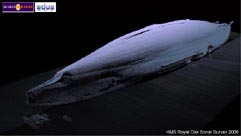
(click on images for larger versions)
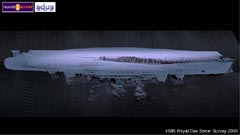
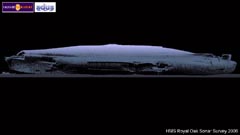
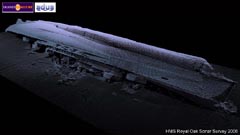
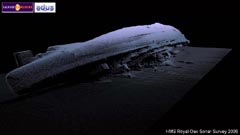
 |
Sonar survey 2006
(click on images for larger versions) |
 |
 |
 |
 |
|
SIXTY-seven years after she rolled over and sank in Scapa Flow, underwater archaeological experts have produced the most detailed sonar images of stricken giant HMS Royal Oak - images the ordinary camera could never capture. Royal Oak fell victim to the skill and audacity of U-boat ace Kapitanleutnant Gunther Prien in U47. He slipped through the defences of the Royal Navy's wartime anchorage in the Orkneys and put four torpedoes into the dreadnought in October 1939. The battleship sank in less than 15 minutes; of her ship's company of more than 1,200, 833 perished. Beyond the immediate aftermath of personal tragedy and harm to British and RN prestige, the Royal Oak disaster has left a more long-standing legacy. For over a decade Whitehall has been trying to prevent oil leaking from the ship's fuel tanks. To date, 884 cubic metres (194,452 gallons) of oil has been pumped out of the wreck; anywhere between 153,000 and 286,000 gallons are thought to be still trapped in her hull. All oil has been removed from Royal Oak's outer tanks using a method called hot tapping, fitting valves at strategic points. What remains lies in her inner tanks. Given Royal Oak's status as an official war grave, the importance of preserving Scapa Flow's environment, and the danger of explosions caused by munitions trapped in the upturned hull, tapping those inner tanks is an extremely delicate task. A pilot scheme using specialist gear in 2005 proved that oil from the inner tanks could be withdrawn. But before any large-scale tapping could begin, a detailed survey of Royal Oak was crucial. The MOD called upon Adus, sonar and wreck survey experts from the University of St Andrews, to find out what state the wreck was in and how stable it was before tapping those inner tanks began in earnest. The Adus team used multi-beam sonars to scan the wreck; this data was then turned into 3D images by computer wizardry. 'The survey work used cutting-edge technology and visualisation techniques specifically developed for this task,' explained Craig English of the Salvage and Marine Operations team. Martin Dean, a maritime archaeologist with Adus, said the result of the survey produced a breathtaking view of Royal Oak's crippled hull, with the places where Prien's torpedoes struck clearly identifiable. For maritime archaeologists and environmental experts, the work proved invaluable. 'The sonar images are of such accuracy that even small changes in the hull over time can be monitored closely year on year,' Mr Dean added. 'This will not only help reduce the impact of a catastrophic failure of the hull should it occur but, better still, allow a much greater understanding of how and when the wreck might break up.' Something no survey could accurately predict was how much the shells, cordite and other ammunition in Royal Oak's magazine had deteriorated. As a result, time spent working on the wreck was kept to a minimum to avoid any potential disturbance. Other disturbance to avoid is that to marine and wildlife at Scapa, in particular wintering seabirds. Consequently, two weeks in September were deemed to be the best time to tap the oil tanks and minimise the risk to wildlife if any oil spilled from the hull. In typical autumnal weather at Scapa (ie cold, wet and windy), a team of expert divers under the guidance of the MOD's Salvage and Marine Operations team began to remove the oil from the inner tanks. 'Despite the challenging weather conditions, the team spirit was very high, boosted by the fact that the support barge steadily filled with viscous, dark Venezuelan furnace oil,' Mr English added. |